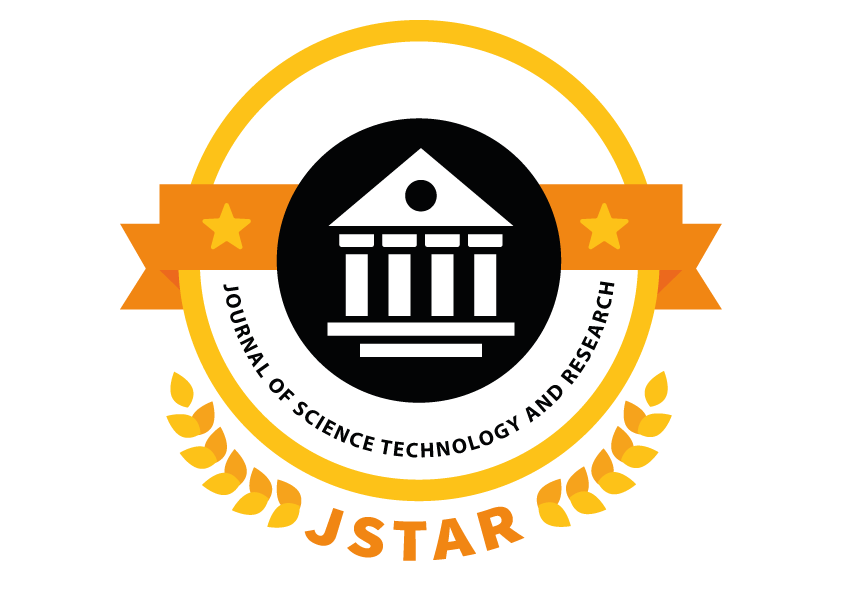Author:
Mahesh Kumar, K.Premkumar, R.SenthilkumarPublished in
Journal of Science Technology and Research( Volume , Issue )
1. Heart Disease Dataset – https://www.kaggle.com/c/heart-disease dated: Sept 2018
2. Effective heart disease prediction using hybrid machine learning techniques Senthilkumar Mohan, ChandrasegarThirumalai, Gautam Srivastava IEEE Access 7, 81542-81554, 2019
3. Heart Disease Prediction Using Machine Learning Algorithms A Singh, R Kumar – 2020 International Conference, 2020-ieeexplore.ieee.org
4. Heart disease prediction using machine learning techniques: a survey by VV Ramalingam, Ayantan Dandapath, M Karthik Raja International Journal of Engineering and Technology 7(2.8), 684-687, 2018
5. Prediction of heart disease using machine learning Aditi Gavhane, GouthamiKokkula, Isha Pandya, Kailas Devadkar 2018
6. Karthick, R., et al. “Overcome the challenges in bio-medical instruments using IOT–A review.” Materials Today: Proceedings (2020). https://doi.org/10.1016/j.matpr.2020.08.420
7. Karthick, R., et al. “A Geographical Review: Novel Coronavirus (COVID-19) Pandemic.” A Geographical Review: Novel Coronavirus (COVID-19) Pandemic (October 16, 2020). Asian Journal of Applied Science and Technology (AJAST)(Quarterly International Journal) Volume 4 (2020): 44-50.
8. Sathiyanathan, N. “Medical Image Compression Using View Compensated Wavelet Transform.” Journal of Global Research in Computer Science 9.9 (2018): 01-04.
9. Karthick, R., and M. Sundararajan. “SPIDER-based out-of-order execution scheme for Ht-MPSOC.” International Journal of Advanced Intelligence paradigms 19.1 (2021): 28-41. https://doi.org/10.1504/IJAIP.2021.114581
10. Sabarish, P., et al. “An Energy Efficient Microwave Based Wireless Solar Power Transmission System.” IOP Conference Series: Materials Science and Engineering. Vol. 937. No. 1. IOP Publishing, 2020. doi:10.1088/1757-899X/937/1/012013
11. Vijayalakshmi, S., et al. “Implementation of a new Bi-Directional Switch multilevel Inverter for the reduction of harmonics.” IOP Conference Series: Materials Science and Engineering. Vol. 937. No. 1. IOP Publishing, 2020. doi:10.1088/1757-899X/937/1/012026
12. Karthick, R., and M. Sundararajan. “Hardware Evaluation of Second Round SHA-3 Candidates Using FPGA (April 2, 2014).” International Journal of Advanced Research in Computer Science & Technology (IJARCST 2014) 2.2.
13. Karthick, R., et al. “High resolution image scaling using fuzzy based FPGA implementation.” Asian Journal of Applied Science and Technology (AJAST) 3.1 (2019): 215-221.
14. P. Sabarish, R. Karthick, A. Sindhu, N. Sathiyanathan, Investigation on performance of solar photovoltaic fed hybrid semi impedance source converters, Materials Today: Proceedings, 2020, https://doi.org/10.1016/j.matpr.2020.08.39015. Karthick, R., A. Manoj Prabaharan, and P. Selvaprasanth. “Internet of things based high security border surveillance strategy.” Asian Journal of Applied Science and Technology (AJAST) Volume 3 (2019): 94-100.
16. Karthick, R., and M. Sundararajan. “A novel 3-D-IC test architecture-a review.” International Journal of Engineering and Technology (UAE) 7.1.1 (2018): 582-586.
17. Karthick, R., and M. Sundararajan. “Design and implementation of low power testing using advanced razor based processor.” International Journal of Applied Engineering Research 12.17 (2017): 6384-6390.
18. Karthick, R., and M. Sundararajan. “A Reconfigurable Method for TimeCorrelatedMimo Channels with a Decision Feedback Receiver.” International Journal of Applied Engineering Research 12.15 (2017): 5234-5241.
19. Karthick, R., and M. Sundararajan. “PSO based out-of-order (ooo) execution scheme for HT-MPSOC.” Journal of Advanced Research in Dynamical and Control Systems 9 (2017): 1969.
20. Karthick, R. “Deep Learning For Age Group Classification System.” International Journal Of Advances In Signal And Image Sciences 4.2 (2018): 16-22.
21. Karthick, R., and P. Meenalochini. “Implementation of data cache block (DCB) in shared processor using field-programmable gate array (FPGA).” Journal of the National Science Foundation of Sri Lanka 48.4 (2020). http://doi.org/10.4038/jnsfsr.v48i4.10340
22. Suresh, Helina Rajini, et al. “Suppression of four wave mixing effect in DWDM system.” Materials Today: Proceedings (2021). https://doi.org/10.1016/j.matpr.2020.11.545
23. M. Sheik Dawood, S. Sakena Benazer, N. Nanthini, R. Devika, R. Karthick, Design of rectenna for wireless sensor networks, Materials Today: Proceedings, 2021. https://doi.org/10.1016/j.matpr.2020.11.905
24. M. Sheik Dawood, S. Sakena Benazer, R. Karthick, R. Senthil Ganesh, S. Sugirtha Mary, Performance analysis of efficient video transmission using EvalSVC, EvalVid-NT, EvalVid, Materials Today: Proceedings,2021. https://doi.org/10.1016/j.matpr.2021.02.287
ABSTRACT:
Prognostic System for Heart Disease using Machine Learning: A Review highlights the growing need for early diagnosis and routine monitoring of heart conditions. In today’s fast-paced world, regular medical checkups have become difficult. Therefore, this system offers an accessible platform that supports online consultation and self-assessment. Users can input personal health attributes such as blood pressure, cholesterol, and diabetes status. The system processes this data using classification techniques in Machine Learning to predict the risk level of heart disease.By analyzing user inputs, the model guides individuals about the seriousness of their condition. This not only helps in early detection but also enables users to track their health over time. Moreover, cloud-based access ensures convenience and wider reach. Ultimately, a Prognostic System for Heart Disease using Machine Learning: A Review offers a vital, AI-assisted step toward improving preventive healthcare and making disease monitoring more personalized, scalable, and accessible.
INTRODUCTION:
Prognostic System for Heart Disease using Machine Learning: A Review explores how Machine Learning and AI assist in predicting various heart conditions such as heart attacks, arrhythmia, and heart failure. These conditions often arise from key health factors like blood pressure, cholesterol, and diabetes. Traditionally, diagnosing these diseases requires complex testing and routine checkups. However, Machine Learning helps simplify the process by analyzing large medical datasets.This system allows users to input their health attributes through an interactive interface. The model compares user data with a trained dataset using classification techniques like Decision Tree, Random Forest, and K-Nearest Neighbors. As a result, it accurately predicts the risk of heart disease. Additionally, the system educates users on the severity of their condition and encourages timely intervention.In summary, Prognostic System for Heart Disease using Machine Learning: A Review empowers individuals with predictive tools for better health awareness and smarter disease management.

